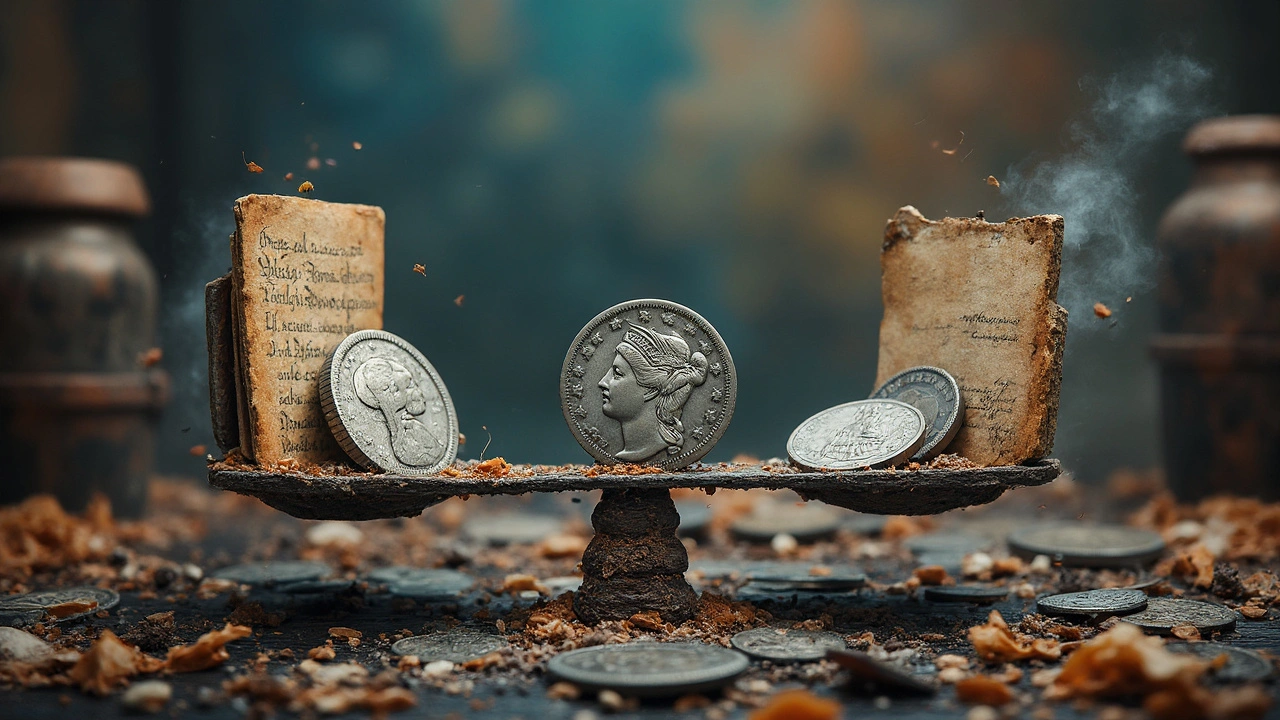Diving into the world of coin collecting? You might've stumbled across the 1853 half dime, a curious little piece of history. Though they stopped minting these around the time your great-great-grandparents were kids, finding one today can feel like stepping back in time. But how much is this old coin really worth?
First thing to know, the 1853 half dime isn’t worth its face value anymore. If you’ve got one, it’s likely worth much more because of its age and rarity. What makes it valuable? Turns out, several things. The coin's condition, any unique features, and the market demand can all play a part in its worth. Coins in top-notch shape or with unique mint marks can fetch some pretty impressive prices!
And if you’re thinking about investing? There are savvy ways to go about it. Knowing where to sell, recognizing a genuine coin, and understanding market trends can make a big difference. Coin collecting isn’t just about what’s in your wallet—it’s about appreciating a slice of history and maybe, just maybe, making a buck while doing it.
- Understanding the 1853 Half Dime
- Factors Influencing Its Value
- Tips for Evaluating the Coin
- Investing in Half Dimes
- Where to Buy and Sell
Understanding the 1853 Half Dime
The 1853 half dime is a fascinating piece of U.S. history. It's tiny—about half the size of a modern dime, if you can imagine that. But don’t let its size fool you; it packs a big historical punch. Minted before the Civil War, it gives you a glimpse into a different era of American life.
Back then, these coins carried a fair bit of everyday purchasing power. Imagine buying groceries with just a pocketful of half dimes! And if you ever wondered why they’re called 'half dimes' and not 'nickels'—well, the answer is silver. Unlike today’s nickels, these were made from pure silver, not a nickel alloy. Pretty neat, right?
Key Features to Spot
Now, here’s what to look for: the obverse features Lady Liberty seated with a liberty cap on a pole. Flip it over, and the reverse shows the denomination surrounded by a wreath. In 1853, arrows were added next to the date to indicate a change in the weight of the coin, making these versions a bit more unique.
| Year | Mint | Production (est.) |
|---|---|---|
| 1853 | Philadelphia | 13,210,020 |
Significance Today
If you’re holding onto one of these little silvery discs, you’ve got something special. Coins minted in 1853 with arrows often attract collectors due to their unique historical context. The design, the year, and the modifications all add to its charm—and potential market value.
So whether you found it in a dusty attic or you’re adding to a growing collection, understanding the history and features of the 1853 half dime can give you a deeper appreciation of this quaint coin.
Factors Influencing Its Value
When it comes to figuring out the worth of a 1853 half dime, several things come into play. Let's break down why your little piece of history might be worth more than you think.
Condition
The first thing to consider is the coin's condition. Coins can range from mint state, where they're practically untouched, to those that have lived a busy life in someone's pocket. Grading services often use a numerical scale, like 1 to 70, to determine this. The closer to 70, the better condition it's considered in and naturally, the higher the value.
Mint Marks
Not all 1853 half dimes are created equal. Some were minted with special marks indicating where they were produced, such as an 'O' for New Orleans. Coins with rarer mint marks might have a higher price tag due to their scarcity. It's worth flipping that coin around and checking for any unusual mint marks which could add to its value.
Rarity
As with any collectible, rarity can hike up the price. If fewer coins were minted in a particular year or with a certain feature, chances are they'd be worth more. For our half dime, it’s estimated that significantly fewer coins were minted in New Orleans compared to Philadelphia, making those variants more desirable among collectors.
Market Demand
The coin market isn't static, and demand can fluctuate based on a variety of factors—from economic conditions to trends in collecting. A surge in interest among collectors for early American coinage can drive prices up. So, keeping an eye on market trends might give you insights on the best times to buy or sell.
| Condition | Average Value |
|---|---|
| Poor | $10-$20 |
| Good | $30-$50 |
| Very Fine | $100-$150 |
| Mint State | $200+ |
Knowing these factors can make all the difference if you're planning to buy, sell, or simply hold onto a 1853 half dime as a cherished keepsake. Each coin carries its own story, and understanding yours could uncover a legacy worth sharing—or cashing in on!

Tips for Evaluating the Coin
Checking out the worth of your 1853 half dime shouldn't feel like rocket science. Let’s break it down and make it as easy as pie.
1. Condition is King
First off, take a good look at the condition. Got a coin with a lot of wear and tear? That might lower the price. Coins rated as 'Uncirculated' or 'About Uncirculated' are usually at the top of the value chart.
2. Keep an Eye Out for Mint Marks
Next, flip it over and see if there’s a mint mark. Some 1853 half dimes have mint marks which can boost the coin’s value. A rare mint mark or error can be a bargaining ace up your sleeve.
3. Authenticity is a Must
Got doubts about whether your coin is legit? Get it graded by a professional grading service. These folks have the tools and expertise to give you peace of mind. The numbers they give can skyrocket your coin's transparency and trustworthiness.
4. Know Your Market
Catching up with the market trends can be your secret weapon. Prices fluctuate, so knowing when to sell or buy can save or earn you big bucks. Watch out for coin auctions and online marketplaces, and definitely join online forums where fellow collectors discuss recent sales.
5. Create a Record
Finally, maintain a record of your coin's history. Document any dealings, previous owners, or sales. This not only helps in negotiations but can also serve as an interesting backstory when you're sharing your collection with others.
Evaluating your coin can be a pretty cool adventure. Armed with these tips, you'll be better prepared to understand the true value of your precious find. And who knows, maybe there's a rare gem waiting in that collection!
Investing in Half Dimes
Ever thought about putting your money into something a bit different than the usual stocks or real estate? Enter the world of coin collecting—specifically, the 1853 half dime. This could be a neat way to diversify your investment portfolio. But like any investment, you've got to know what you're getting into.
Why Invest in Half Dimes?
Half dimes might be small, but they punch above their weight class in terms of historical value and collector interest. Not only are you acquiring a piece of the past, but coins like the 1853 half dime often appreciate over time, especially if they’re in superb condition.
Alice Lerrow, a renowned numismatist, once said, "Coins are little snippets of history. When you invest in them, you're not just buying an object; you're preserving a narrative."
What to Consider
Before jumping in, here are a few things to consider:
- Condition Matters: Coins graded high on the Sheldon Scale tend to command much higher prices.
- Rarity: If your coin has a low mintage number, it could be more valuable.
- Market Trends: Keep an eye on the demand for these coins. Just like any market, trends can shift, affecting your investment's value.
Buying and Selling Tips
It's important to buy from reputable dealers to avoid counterfeits. Building a relationship with a reliable dealer can provide opportunities for purchasing coins that are in good demand.
Selling is all about timing and the market's interest. Stay updated with coin auctions where you might find the perfect opportunity to cash in on your half dime investment.
Did you know that, according to a study by the American Numismatic Association, many collectible coins have seen an annual rise in value between 4-8%? Combine that with a genuine interest in the stories they tell, and you're not just investing in coins; you're investing in history itself.

Where to Buy and Sell
So, you've decided to jump into the world of coin collecting. You're wondering where you can snag an 1853 half dime or how to sell one you've got tucked away. Thankfully, there are plenty of options, both online and offline, each with its perks.
Buying Coins
Online Marketplaces are super accessible for beginners and seasoned collectors alike. Websites like eBay or Coin Auction sites often have a range of options. Just make sure you’re buying from a reputable seller—check ratings and reviews before you commit.
If you're after a more personal touch, head to a local coin shop. The benefit here is having a face-to-face chat with an expert. You can inspect the coin in person, assess its condition, and get professional insights, which is harder to do online.
Selling Coins
Got a half dime you want to sell? The strategies are pretty similar. Online Marketplaces can reach a broader audience quickly, but it’s essential to provide clear photos and detailed descriptions. Let potential buyers know about the coin’s condition, any special marks, or certificates of authenticity.
For those who prefer an offline approach, attending coin shows is fantastic. These events gather enthusiasts and dealers, providing a chance to showcase your coin to potential buyers directly. It's also a great way to network with other collectors.
Finally, did you know that auction houses can be an option if you believe your 1853 half dime is particularly valuable? It’s a bit more formal, but this route can sometimes fetch higher prices with the right audience.
| Platform | Pros | Cons |
|---|---|---|
| Online Marketplaces | Wide reach, convenience | Potential scams, less personal |
| Coin Shops | In-person interaction, expert advice | Limited stock |
| Coin Shows | Networking, direct buyer interaction | Time-consuming |
| Auction Houses | Potentially higher prices | Higher fees, more formal |
Remember, whether buying or selling, knowledge is your best asset. Knowing the current market trends and the value of your coin will help you make smarter decisions and potentially bag a great deal.






